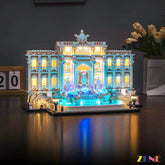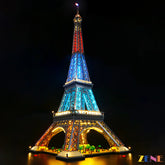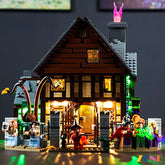How Tiny Brick Won the Hearts of Children Worldwide
LEGO’s journey from wooden toys to illuminated plastic masterpieces showcases a legacy of love, innovation, and timeless appeal. From the early Red House and wooden duck to the revolutionary tubular coupling system in 1958, LEGO has consistently inspired creativity across generations. Modern advancements like LED lighting and motorized components elevate LEGO’s possibilities, blending tradition with technology. This enduring toy not only connects the past and present but also empowers builders to create and innovate, proving that with LEGO, anything is possible.
A Legacy of Love & Innovation
Mini Ole Kirks Red House
Wooden Duck Toys
From Plastic Bricks to Build Anything
Technic Power Functions
Inspiring Creativity Through Play
A Legacy of Love & Innovation
When it comes to construction toys, LEGO instantly springs to mind. This beloved toy, assembled from countless small pieces, evokes both love and frustration among its enthusiasts. On one hand, its exquisite craftsmanship, stunning aesthetics, and the sheer joy of assembly create an immensely satisfying experience. The sense of achievement upon completing a LEGO creation is truly unparalleled.
What makes LEGO truly remarkable is its incredible consistency across generations. When a toy becomes this precious, it transforms into a family heirloom, chronicling the passage of time through generations. A LEGO piece from a grandfather's collection from the mid-20th century can perfectly interlock with his grandson's modern LEGO blocks today. It's like witnessing a time-traveling tableau, where past and present seamlessly merge, capturing precious childhood memories across different eras.
Mini Ole Kirks House
Among LEGO collections, you occasionally discover special pieces that stand out - like the legendary Red House and Mother Duck. These vintage pieces serve as powerful testimony to LEGO's timeless appeal.
The story of the Red House begins in 1916 when Ole Kirk Kristiansen, LEGO's founder, purchased a red house at the age of 25. There, he started his wooden toy-making business. However, disaster struck in 1924 when a devastating fire reduced his enterprise to ashes. Demonstrating remarkable resilience, Ole Kirk rebuilt the Red House that same year, transforming it into a factory that still stands today. This house became the birthplace of LEGO as we know it.

In a touching tribute to this heritage, LEGO created a special Christmas gift for company veterans in 2012 - a LEGO version of the iconic Red House.
Wooden Duck Toys
LEGO didn't start with plastic bricks - its journey began with wooden toys. The charming wooden duck was actually LEGO's very first product. In a nostalgic tribute to this heritage, LEGO recreated this iconic wooden duck in 2011.

The story starts in the small Danish town of Billund, where Ole Kirk Christiansen, born in 1891, established his legacy. A skilled carpenter by trade, he owned a woodworking shop.
Plastic Bricks
A significant transformation occurred in 1947 when LEGO produced its first plastic toys. This pioneering collection included baby rattles and "sailor" toys, alongside an array of other plastic creations like cars, tractors, airplanes, and animals.

However, the first version of LEGO bricks was quite different from what we know today. These early bricks lacked the internal tubular system that would later become LEGO's signature feature. Without this crucial interlocking mechanism, larger constructions were unstable and prone to collapse when moved.
Basic Bricks to Illuminated Innovation
The LEGO we know and love today traces its modern form to a revolutionary innovation in 1958, when the company introduced the tubular coupling system inside its bricks. This seemingly simple addition transformed LEGO forever, enabling perfect interlocking between pieces regardless of when they were manufactured. This universal compatibility unleashed unlimited creative possibilities.
LEGO Can Build Anything
Today's LEGO has evolved far beyond simple plastic bricks. The introduction of LED lighting elements has added a new dimension to LEGO creativity, allowing builders to create stunning illuminated displays. Imagine cityscapes that glow at night, just like their real-world counterparts, or vehicles with working headlights and signals.

Technic Power Functions

The LEGO Technic Power Functions series has taken this innovation even further, introducing motorized components that bring creations to life. These advanced sets include:
- Remote-controlled motors for vehicles and machinery
- Programmable elements for automated movement
- Working mechanical systems that mirror real engineering
- LED lighting systems integrated with moving parts
Modern LEGO sets combine these technological advances with traditional building techniques, creating experiences that were unimaginable in 1958. Whether it's a sports car with working LED headlights, a skyscraper illuminated from within, or a fully motorized construction vehicle, the possibilities seem endless.
Inspiring Creativity Through Play
From a simple wooden duck to illuminated architectural masterpieces and powered vehicles. Builders can combine classic bricks with these modern elements, creating unique hybrid creations that span LEGO's entire history. This blend of old and new, simple and complex, static and dynamic, continues to inspire builders of all ages to push the boundaries of what's possible with LEGO bricks.













Leave a comment
All blog comments are checked prior to publishing